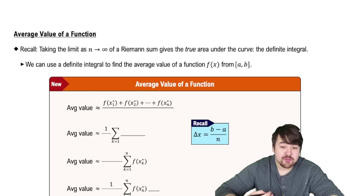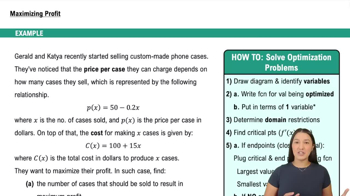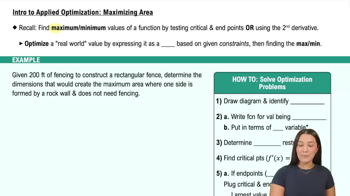41. Among all triangles in the first quadrant formed by the x-axis, the y-axis, and tangent lines to the graph of y=3x-x^2, what is the smallest possible area?
Table of contents
- 0. Functions7h 54m
- Introduction to Functions16m
- Piecewise Functions10m
- Properties of Functions9m
- Common Functions1h 8m
- Transformations5m
- Combining Functions27m
- Exponent rules32m
- Exponential Functions28m
- Logarithmic Functions24m
- Properties of Logarithms36m
- Exponential & Logarithmic Equations35m
- Introduction to Trigonometric Functions38m
- Graphs of Trigonometric Functions44m
- Trigonometric Identities47m
- Inverse Trigonometric Functions48m
- 1. Limits and Continuity2h 2m
- 2. Intro to Derivatives1h 33m
- 3. Techniques of Differentiation3h 18m
- 4. Applications of Derivatives2h 38m
- 5. Graphical Applications of Derivatives6h 2m
- 6. Derivatives of Inverse, Exponential, & Logarithmic Functions2h 37m
- 7. Antiderivatives & Indefinite Integrals1h 26m
- 8. Definite Integrals4h 44m
- 9. Graphical Applications of Integrals2h 27m
- 10. Physics Applications of Integrals 3h 16m
- 11. Integrals of Inverse, Exponential, & Logarithmic Functions2h 31m
- 12. Techniques of Integration7h 41m
- 13. Intro to Differential Equations2h 55m
- 14. Sequences & Series5h 36m
- 15. Power Series2h 19m
- 16. Parametric Equations & Polar Coordinates7h 58m
5. Graphical Applications of Derivatives
Applied Optimization
Problem 4.5.60
Textbook Question
Business and Economics
60. Production level Prove that the production level (if any) at which average cost is smallest is a level at which the average cost equals marginal cost.
 Verified step by step guidance
Verified step by step guidance1
Define the average cost (AC) as the total cost (C) divided by the quantity produced (Q), i.e., AC = C/Q.
Define the marginal cost (MC) as the derivative of the total cost with respect to quantity, i.e., MC = dC/dQ.
To find the production level where the average cost is smallest, take the derivative of the average cost with respect to quantity, d(AC)/dQ, and set it equal to zero to find critical points.
Use the quotient rule to differentiate AC = C/Q, which gives d(AC)/dQ = (Q * dC/dQ - C) / Q^2.
Set the derivative d(AC)/dQ equal to zero and solve for Q, which simplifies to Q * MC = C, or AC = MC, proving that the production level where average cost is smallest is where average cost equals marginal cost.
 Verified video answer for a similar problem:
Verified video answer for a similar problem:This video solution was recommended by our tutors as helpful for the problem above
Video duration:
4mPlay a video:
Was this helpful?
Key Concepts
Here are the essential concepts you must grasp in order to answer the question correctly.
Average Cost
Average cost is the total cost of production divided by the number of units produced. It is a measure of the cost per unit of output and is crucial for determining the efficiency of production. Understanding average cost helps in analyzing how costs behave as production levels change.
Recommended video:

Average Value of a Function
Marginal Cost
Marginal cost is the additional cost incurred by producing one more unit of a good or service. It is derived from the derivative of the total cost function with respect to quantity. Marginal cost is essential for decision-making, as it helps determine the optimal level of production where profits are maximized.
Recommended video:

Example 3: Maximizing Profit
Optimization in Calculus
Optimization involves finding the maximum or minimum value of a function. In the context of production, it is used to find the level of output that minimizes average cost. This often involves setting the derivative of the average cost function equal to zero and solving for the production level, which is where average cost equals marginal cost.
Recommended video:

Intro to Applied Optimization: Maximizing Area

 1:13m
1:13mWatch next
Master Intro to Applied Optimization: Maximizing Area with a bite sized video explanation from Patrick
Start learningRelated Videos
Related Practice
Textbook Question
